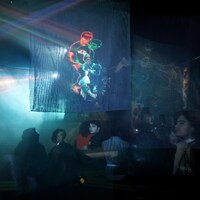Here, the musician discusses the controversies of making music with a text-to-audio generator, and how AI art could help us learn what it means to be human
If you took the Avalanches’ seminal, sample-heavy album Since I Left You and filtered it through the online spaces that bloomed toward the start of the new millennium – all warbly, lo-fi beats and dial-up sounds – then you might arrive at something like patten’s Mirage FM. Released in April, the musician’s first new album in three years employs a similarly eclectic approach, pulling from a wide range of genres and embracing what patten calls the “aesthetics of failure”.
There’s just one twist: Mirage FM is the first LP made entirely from AI-generated sound sources, created by the neural network Riffusion, which turns text prompts into a few seconds of (occasionally-listenable) audio. Instead of lifting samples from vinyl, patten spent hours “crate digging in latent space”, meaning every sound on the record is an original product of his imagination, fed through a machine that draws on centuries of music history. AiDM, if you like.
patten (AKA the experimental electronic musician and audiovisual artist Damien Roach) has been releasing music since 2006, including the 2011 LP Glaqjo Xaacsso, 2016’s Ψ, and a trio of albums released in 2020 via his label and creative agency 555-5555. As a visual artist, he’s been working with AI since “basically as soon as it was possible” – long before the likes of DALL-E 2 or Midjourney entered the mainstream. “I’m interested in the way that you can use these systems to hack the visual, or to break things down to the point of near-unintelligibility,” he explains, adding that AI images can help expose the often-overlooked sense-making operations that govern how we see the world.
That being said, patten wasn’t particularly interested in AI music generation until he stumbled across Riffusion around the end of last year. “It’s basically a text box, where you type in what you’d like to hear, and it spits out some stuff,” he says. “I was really shocked that it was possible to do that, but suddenly there was just this tool in front of me, and it was free.” patten quickly started experimenting with different text prompts, testing the generator’s limits and comparing his output to sounds other people had posted on social media.
“The thing I was really surprised by was how the examples that were on Twitter, and the examples that were on [the Riffusion] website, didn’t seem to scratch the surface of what was actually possible,” he says, comparing them to the intentionally-lowkey mixes that Lofi Hip Hop Girl listens to 24-hours a day – basically, background noise.
The building blocks of Mirage FM came out of one long session with Riffusion. “I ended up spending more or less a day and a half without really sleeping, just making hours and hours and hours of recordings of this stuff,” patten says. “The thing with [AI] tools is the more you experiment with them, the more you figure out how to talk to them and how to get them to do different things, using your own words to explore the terrain of that particular dataset, or what that particular application can do.”
To turn the snippets of sound into actual tracks required hours of chopping, sequencing, layering, EQ, repitching, and adding effects, resulting in an album that glitches between pop, techno, hip hop and grime, R&B, and ambient, tied together by an uncanny atmosphere of distortion and decay. Officially released on April 14, each track on Mirage FM is also accompanied by a “self-directed, AI-assisted” video, featuring visuals that are incorporated and remixed during patten’s exploratory live performances.
Watch an exclusive premiere of patten’s kaleidoscopic video for “Green & Pink” above. Read our conversation with the musician on Mirage FM, AI creativity, and how it could help us understand what it means to be human, below.

Some people see AI as a tool, others see it as an assistant, or even a collaborator. How did you think of Riffusion, when you were making Mirage FM?
patten: It felt like a tool for sure. The thing is, an artist has agency, and this tool didn’t do anything I didn’t ask it to do. Of course, there is a kind of back and forth between a user and a tool, in that a tool suggests ways that it should be used – its design, its manufacturing, its whole structural setup governs its correct usage. A hammer would be a bad tool to use to open your laptop or something, because it’s just not designed for it, but it’s great hammering in nails. But you might also be able to hack the thing, and get it to do things that it wasn’t designed to do. Which is sometimes where things get quite interesting.
Whatever kind of tool I’m using, whether that’s a guitar, or a paintbrush, or Photoshop or a camera, I suppose I’m pretty driven by the desire to try and find different ways of using things, to get results that exist slightly outside the parameters that have been defined by the common usage of that tool.
Mirage FM is very diverse, genre-wise. How did you curate the overall sound?
patten: When I was experimenting with [Riffusion], one thing I was interested to find out was what it knew about, you know, if there were gaps in its dataset and things like that. So I was kind of exploring. ‘Oh, does it know about this kind of music, that kind of music?’ I didn’t start experimenting with it thinking, ‘Okay, I’m making an album.’ I was just doing it because it was interesting, and then after maybe a couple of hours, I was like, ‘Wait, there’s interesting potential here to use this stuff as samples, and to stitch them together to make music of some kind’. So it got a bit more intentional, but the actual act of exploration and how I ended up hitting on these different genres was partly out of that playing process.
“The tool itself is quite lo-fi, so there is this kind of spectral quality to it... it made me think a lot about the aesthetics of failure” – patten
Where do you think the AI shines through most on the album?
patten: The tool itself is quite lo-fi, it’s quite a low bit rate, the sound that it spits out. And so there is this kind of spectral quality to it, that I think is something that discouraged a lot of people from using it to make stuff that they would release. For me, it made me think a lot about the aesthetics of failure, and how they present within music. It seemed very similar to vinyl crackle, or the sound of warbly old cassettes. I was thinking about whether there was something in that early dial-up, failing-internet-connection sort of sound that could have an aesthetic quality. In the end, was really interested in celebrating and sort of just really zoning in on that strange sonic quality.
Was there anything that particularly surprised you about working with AI?
patten: What’s funny is the whole process was full of surprise, from beginning to end. Even now, I’ve been really surprised and touched by hearing from people about how emotionally affecting they found the music. I think that’s really important, in terms of what I do, and why I do it. One of the bits of discourse around AI-assisted creativity is this idea of things being inhuman, or without feeling. One of the things I was really trying to articulate in this album was that it doesn’t have to be like that. I think it’s as much about the creator, the person who’s deciding what to conjure up from the systems, and also what to do with the stuff that’s conjured up as well.
On top of that, one thing I find really interesting about these systems is the way that it’s giving access to all sorts of cultural artefacts from the history of humanity, for anybody to hack and rewire and reroute and make their own. That’s quite interesting, giving that ability to use history as paint, and to make whatever you can imagine. I think that’s really exciting.

Do you think there’s still a stigma against incorporating AI into your creative process?
patten: 100 per cent. Some people, when they hear AI is involved in something, they’re just immediately turned off by it, which I totally understand. I can’t say that it’s all positive, because for some people it’s about efficiency, it’s about making things cheaper and faster, that kind of thing. That’s not where my interest lies in it. My interest is, as I’ve said, reaching outside of the known, trying to find new forms of imagery and audio that maybe speak to what it is like to be a person existing in the present.
There may be people who are [using AI] but they’re just keeping it quiet, because they don’t want to face that potential negativity that can be attached to using AI in your work. My main worry, actually, is that artists and listeners [are] driven away from really exciting potentials in terms of aesthetic experience, or new ways of making things, because of the way that a lot of the discourse is framed around things like that Drake track [the AI-generated ‘Heart On My Sleeve’], where someone is basically making a fake version of something that’s really popular. But that’s not the only thing that you can do using these sorts of systems.
You’ve talked about your desire to expose the mechanics of human perception through art, and AI seems uniquely poised to help with that. What do you think we can learn about our own intelligence from AI, and how machines see the world?
patten: So many conversations coming from looking at AI-assisted image and sound generation systems [start] with having to ask these questions. ‘What are the creative arts? What is consciousness? What is thought?’ I think that’s really fascinating, because it is almost like a mirror, a weird, kind of hazy, blurred out mirror of ourselves and our cognition.
What art can do and what art does do, whether that’s a love song that articulates what something feels like, or a Bridget Riley painting that makes our eyes go funny... art allows us to access a position of reflection, where we can be like, ‘Oh, I’m here. This is the world. This is a tree, this is love, this is anger, this is identity, this is nationhood, this is sexuality, whatever’. Art of all kinds, in its best moments, gives us a window that both clarifies what is going on in all of those interactions between us and the world and other people, but also distorts it. It’s both the clarifier and a distorting agent that makes visible that which is often unseen.
Mirage FM is out now via 555-5555, and is also available as a Bandcamp-only limited edition home-burnt CDR.




